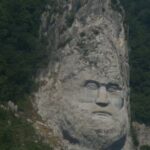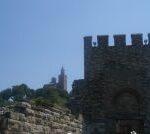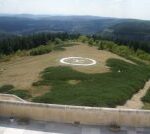Reminiscences 2024
Downstream from Osijek, there weren’t many stops at cities on the Danube.

 Cruising the Danube meant going through the Iron Gates, an 83 mile stretch that includes four gorges, remembrances of Trajan’s efforts to subdue the barbarians along the river, and a modern carving of Decebalus, the king who fought Domitian and Trajan in a vain effort to preserve Dacia. It was commissioned by a Romanian businessman in the 1990s and took ten years to complete the 180 foot statue. Ironically, across the river, on the Serbian side, there’s a plaque marking Trajan’s military road. The Romanian wanted to carve a Roman emperor on that side, but Serbia refused. The gorges, like their counterparts on the Yangtze, were tamed by a dam which smoothed rapids and made navigation easier.
Cruising the Danube meant going through the Iron Gates, an 83 mile stretch that includes four gorges, remembrances of Trajan’s efforts to subdue the barbarians along the river, and a modern carving of Decebalus, the king who fought Domitian and Trajan in a vain effort to preserve Dacia. It was commissioned by a Romanian businessman in the 1990s and took ten years to complete the 180 foot statue. Ironically, across the river, on the Serbian side, there’s a plaque marking Trajan’s military road. The Romanian wanted to carve a Roman emperor on that side, but Serbia refused. The gorges, like their counterparts on the Yangtze, were tamed by a dam which smoothed rapids and made navigation easier.

 Bulgaria included a trip to the capital of the Second Bulgar Empire (1180 until the early 1400s, though by that time it was a shadow of the landmass that stretched from the Baltic to the central Balkans). The entry in Wikipedia makes the history sound like almost constant warfare with and against the Byzantines until finally succumbing to the Ottomans.
Bulgaria included a trip to the capital of the Second Bulgar Empire (1180 until the early 1400s, though by that time it was a shadow of the landmass that stretched from the Baltic to the central Balkans). The entry in Wikipedia makes the history sound like almost constant warfare with and against the Byzantines until finally succumbing to the Ottomans.

 Tarnovo aka Tarnovograd became Veliko Tarnovo in 1965–Great Tarnovo–to honor its historical importance in the first and second Bulgarian Empires. In 1879, delegates here voted to move the capital to Sofia, but in 1908 Tsar Ferdinand (born a German prince) formally declared Bulgaria independent.
Tarnovo aka Tarnovograd became Veliko Tarnovo in 1965–Great Tarnovo–to honor its historical importance in the first and second Bulgarian Empires. In 1879, delegates here voted to move the capital to Sofia, but in 1908 Tsar Ferdinand (born a German prince) formally declared Bulgaria independent.
 There was a bizarre stop on the way back to the boat: it was the Buzludzha monument, a monstrosity opened in 1981 to celebrate socialism and
There was a bizarre stop on the way back to the boat: it was the Buzludzha monument, a monstrosity opened in 1981 to celebrate socialism and communism in Bulgaria. It has not been maintained since the fall of the party, however. Looks like a spaceship!
communism in Bulgaria. It has not been maintained since the fall of the party, however. Looks like a spaceship!